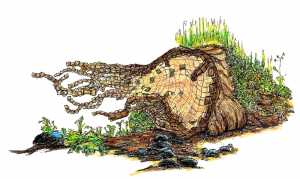Capitola Tree Stump Project Proposal
City Council has approved project concept and agreement with Anthony Heinz May for installation. Project installation TBD.
SITE AND PROJECT DESCRIPTION
Capitola’s Tree Stump Art Project is located at the lower public parking lot (Appendix 2) on Monterey Ave. which is used most by the general population visiting the beach and Capitola Village. This tree stump is estimated to be over 100 years old and arrived at its location from as a result of a mudslide from heavy rains in 2019. The stump is in a way a landmark for the town and a small bit of Capitola’s history.
During the rains of 2019, the original tree slid down the hill above the parking lot and landed on its side. From there, much of the tree was cut and removed leaving only the stump now still lying on its side atop the parking lot asphalt. It is approximately 7 feet in diameter and 4 feet deep (Appendix 1 – Photos).
The art project should incorporate proper preservation of the stump and include any measures necessary to maintain its integrity. For this project, the artist can modify the tree stump to improve its appearance, including but not limited to augmenting, carving, etching, whittling, chiseling & shaping. Artists should ensure that their art meets all ADA requirements as well as local building codes (see attached relevant codes). Pedestrian friendly aspects such as convenient hand holds, pinch points, snag points and vandalism concerns should be considered. Materials used should be weather resistant.
Capitola Village is located along a wide beach with a breathtaking view of the Monterey Bay and is home to numerous craft galleries, boutiques and restaurants. It is here where many events have taken place such as the Capitola Beach Festival, Art and Wine Festival, Twilight Concerts, Art shows, and the Begonia Festival. In addition to these events, Capitola beach is a popular destination spot for tourists. This tree stump will be visible to many thousands of people annually entering the village.
Excerpt from Anthony Heinz May's proposal
"See Level
See Level in title is a play on words originally meant to derive land-spatial measurement. An
intentional malapropism of the word sea for see provokes gameplay for the reader to look at
my sculpture as a puzzle. Sea levels are imaginary lines which land above/below tides
fluctuate. See Level is an eye-line for seeing; the level at which eyes read surrounding spaces.
The images within this proposal support my intent to create a physical composition using
remnants of the Cypress tree stump as a base for sculpture. The public installations of art I
create involve an empirical process of (re)construction that responds to the environment. Mine
is an in-situ process, and so I cannot portray exactly what will develop. My sketch concepts
offer variation of designs for creating sculpture in submission to the Tree Stump Art Project.
Only the stump from this Cypress tree remains, so I plan to seek local parks services for
possible materials from other Cypress trees in the area removed through stewardship of civic
and park spaces. I will graft that material onto the stump base to appear as if the wood cubes
of material came naturally from the tree stump. The material can also be replaced by other
species of trees similar to Cypress such as cedar, etc. and/or lumber where needed. The
creative build is determined by material available for integration into the final composition.
A main point of interest for creating this sculpture is the surrounding area on location of the tree
stump. The flora combined with the fluid/broken design of sculpture suggests a tree trunk as
submerged, or underwater. In this way the sculpture appears to ebb and flow surreally away
from the stump base in a pulling of the tide or by wave energy. See Level functions as a past/
present/future state of the conditions of environmental change where parts of land above water
are engulfed/submerged by water, where the flora above water translates to aquatic plant life
and seabed environments. The Juan de Fuca line dotting the underbelly of West Coast Pacific
Rim of North America provides a broken contour, affecting sea level averages there. See Level
suggests awareness for human existence within this invisible, however very much real space."
Questions? For more information, contact Nikki Bryant LeBlond 831-475-5935, nbryant@ci.capitola.ca.us.

